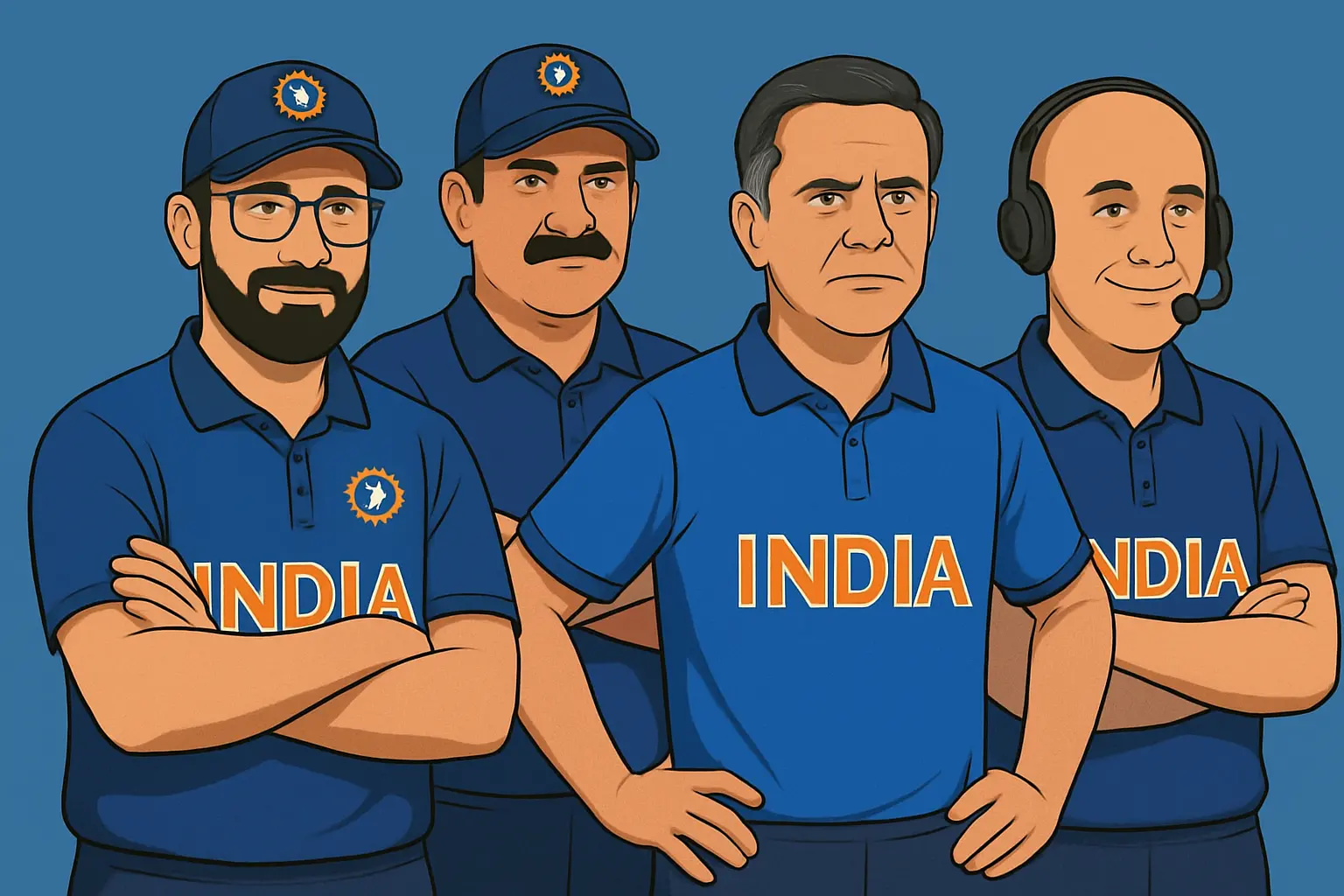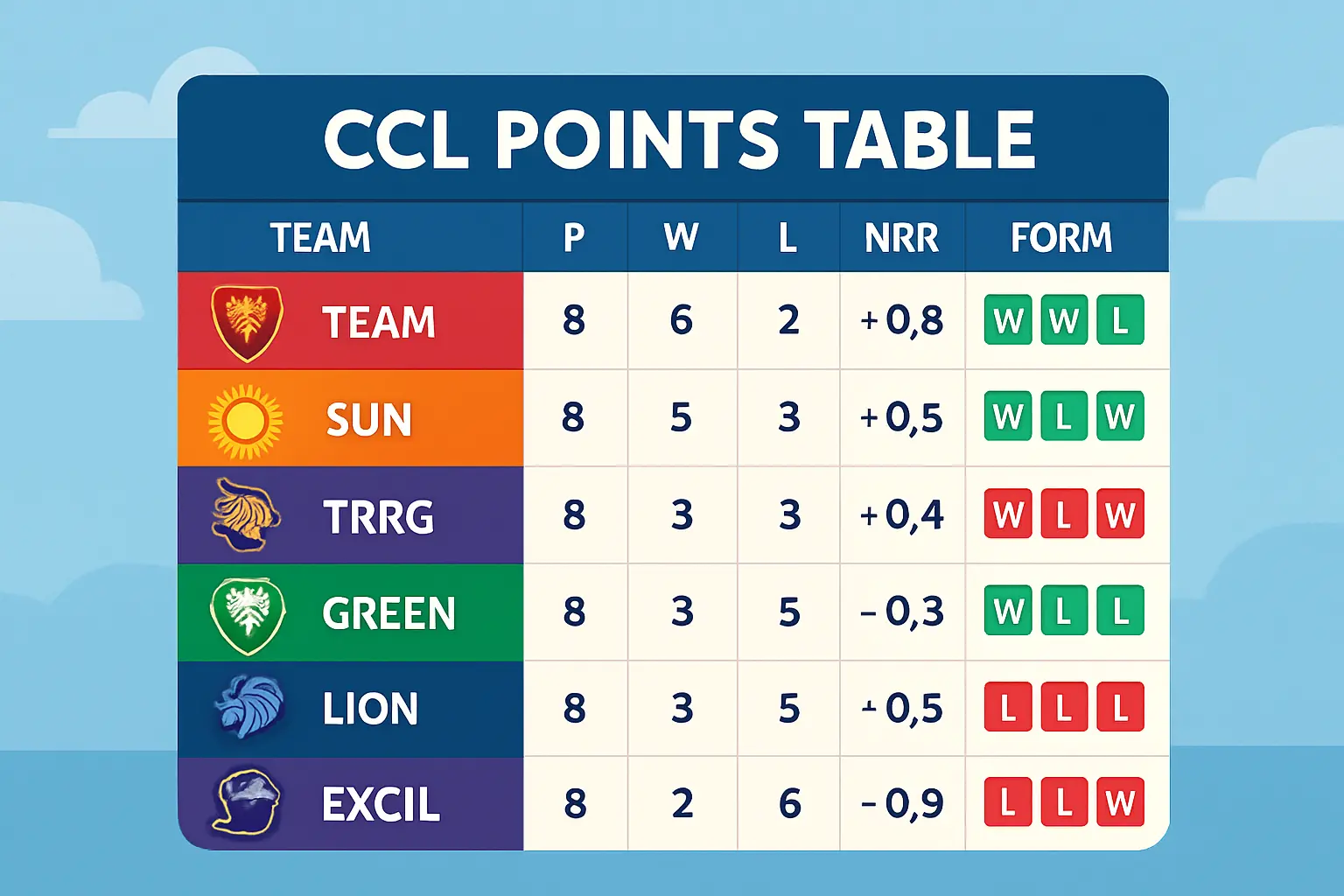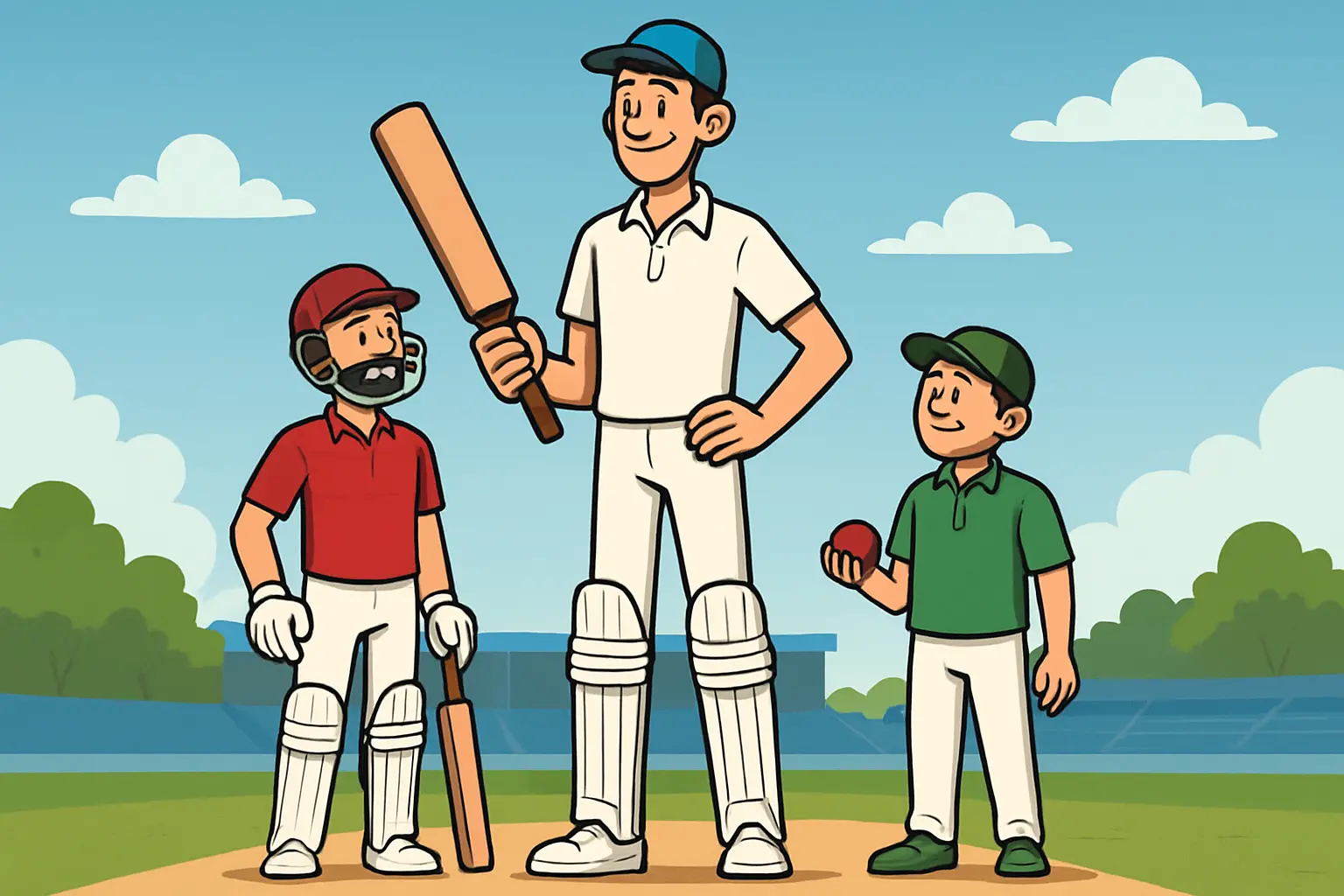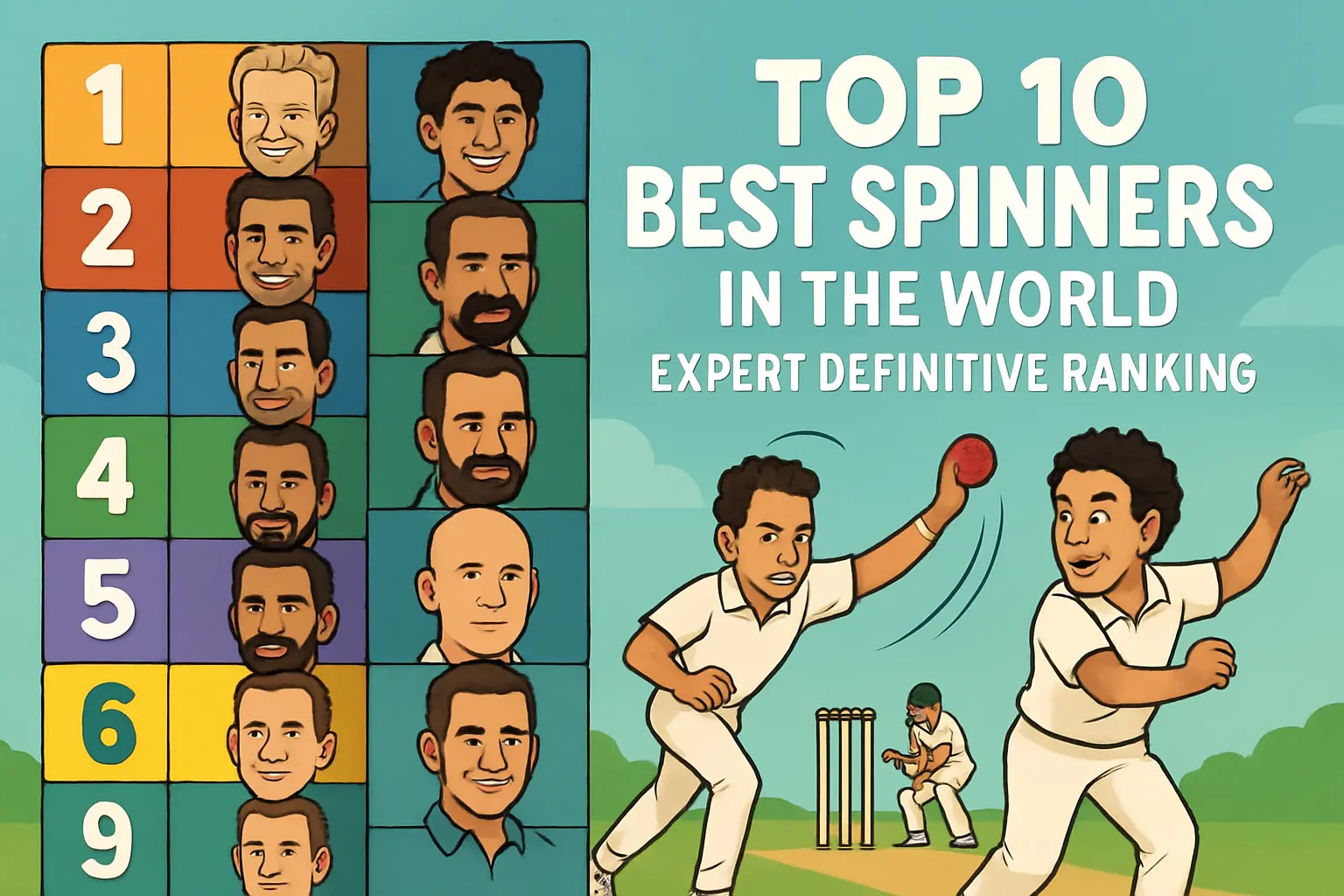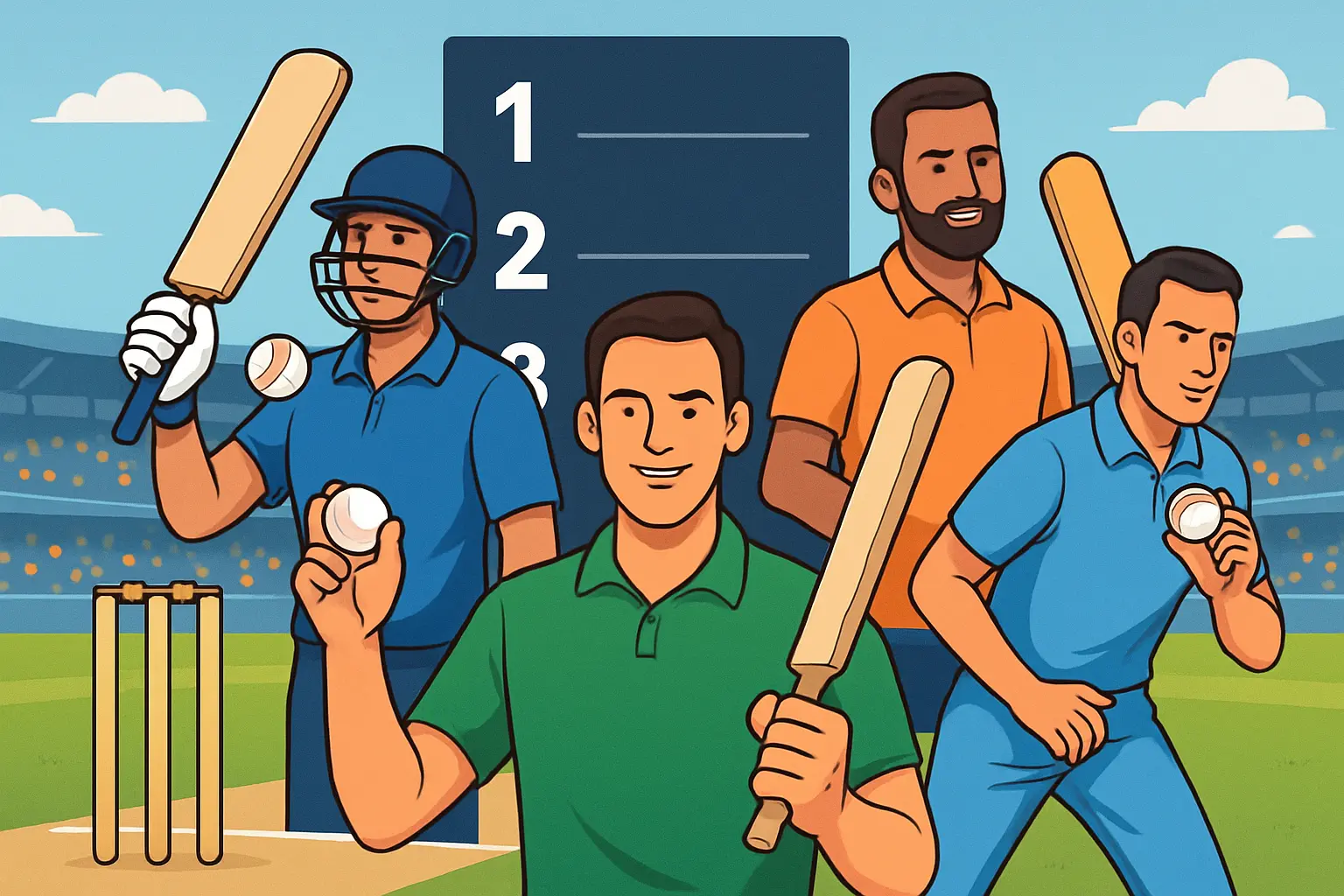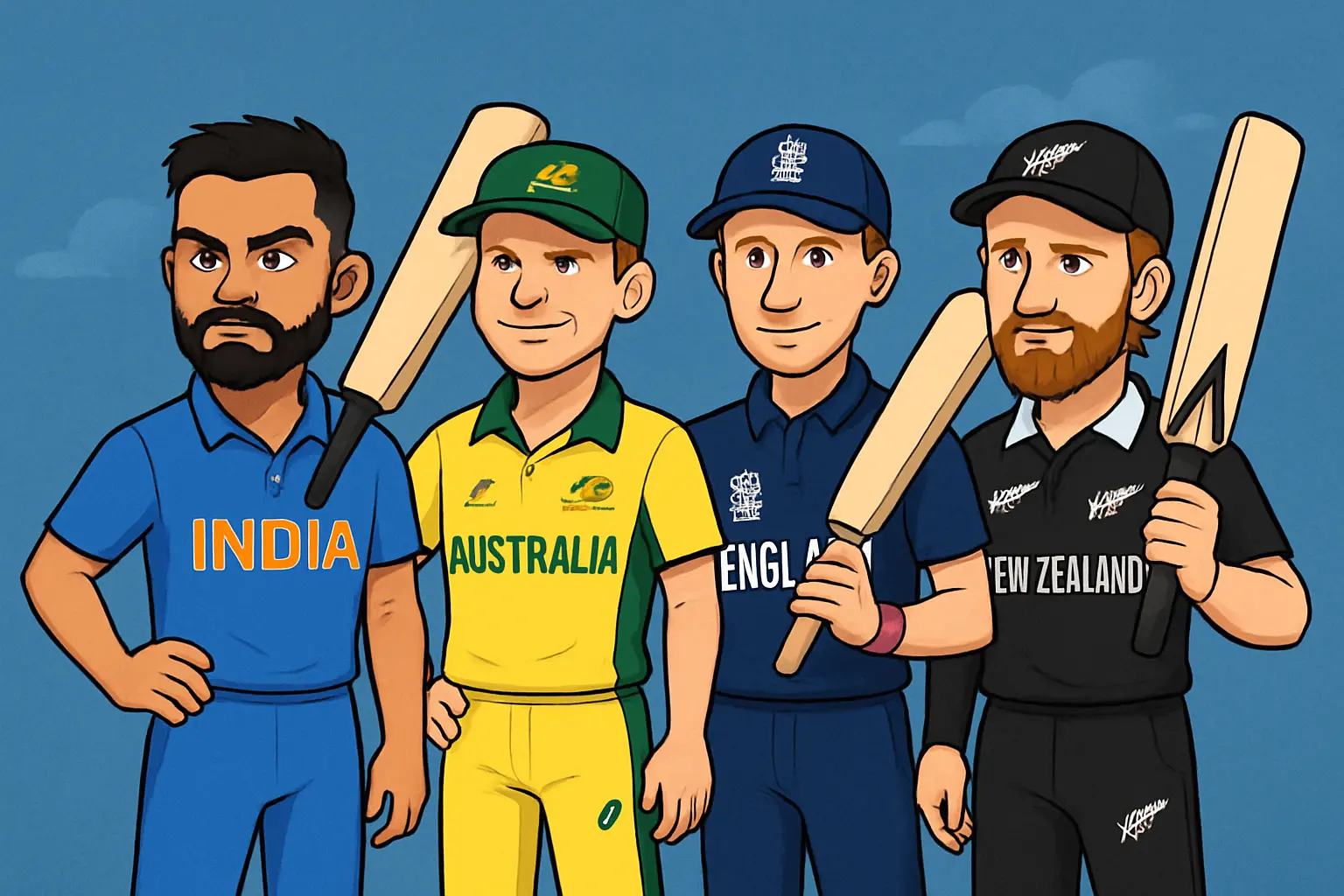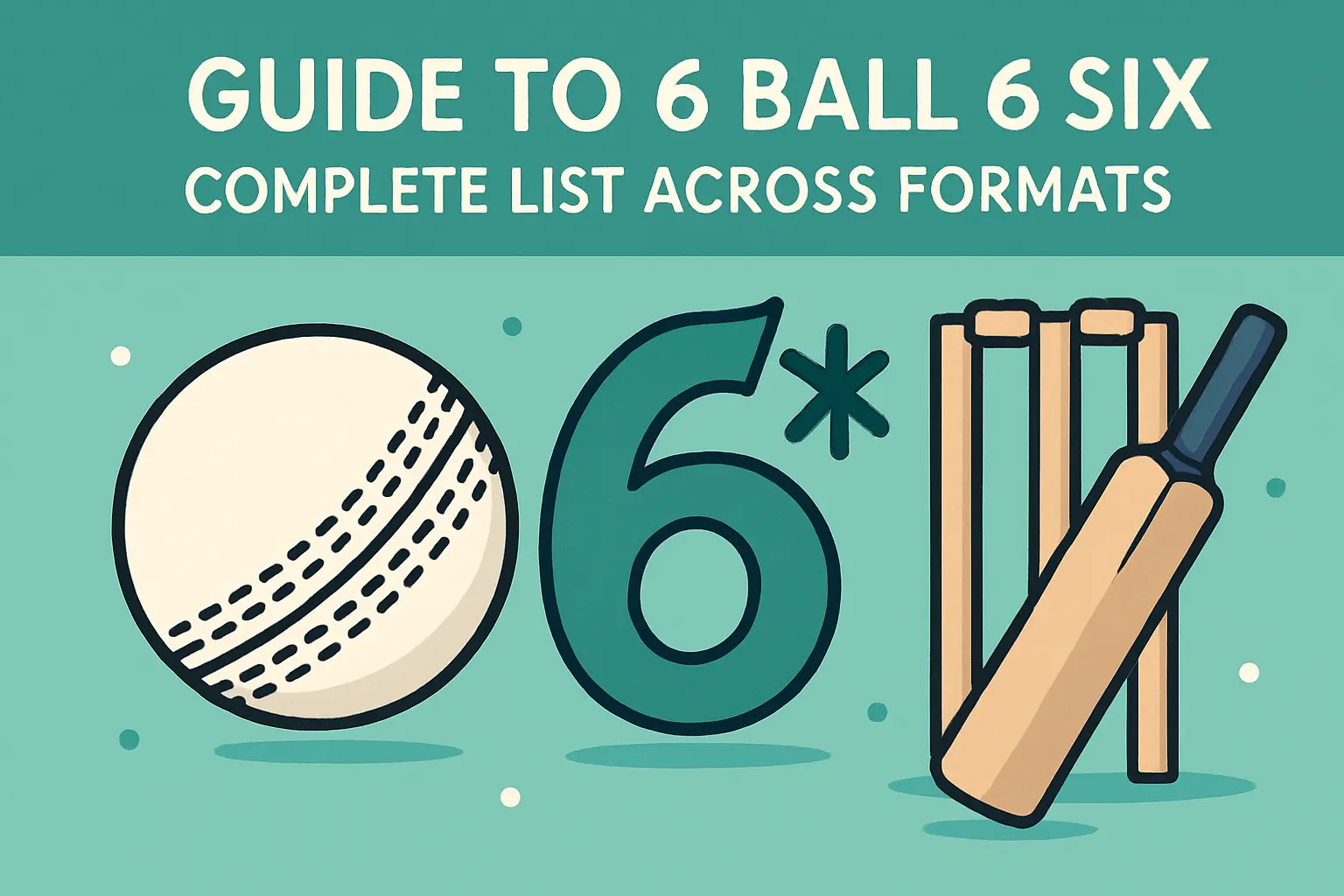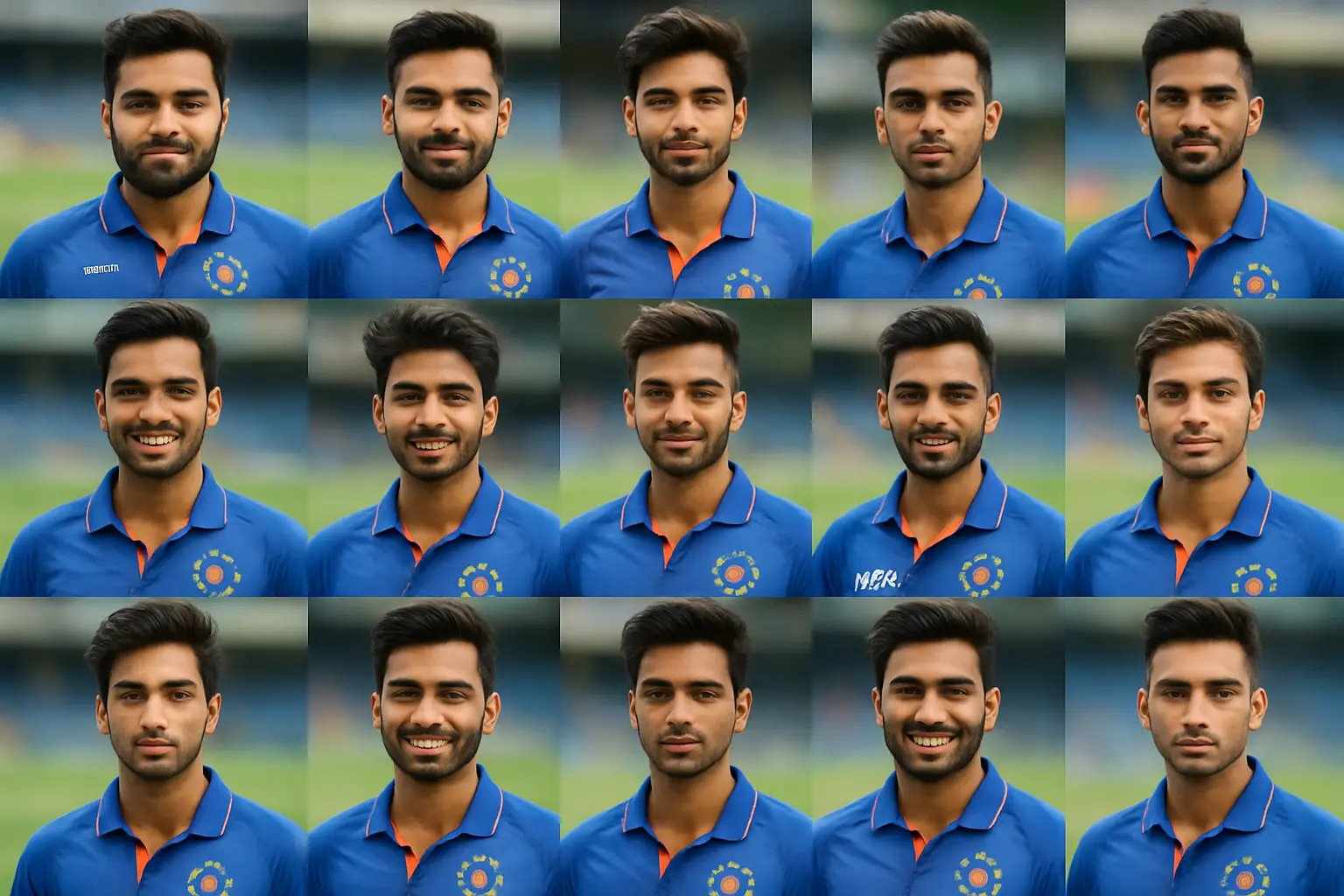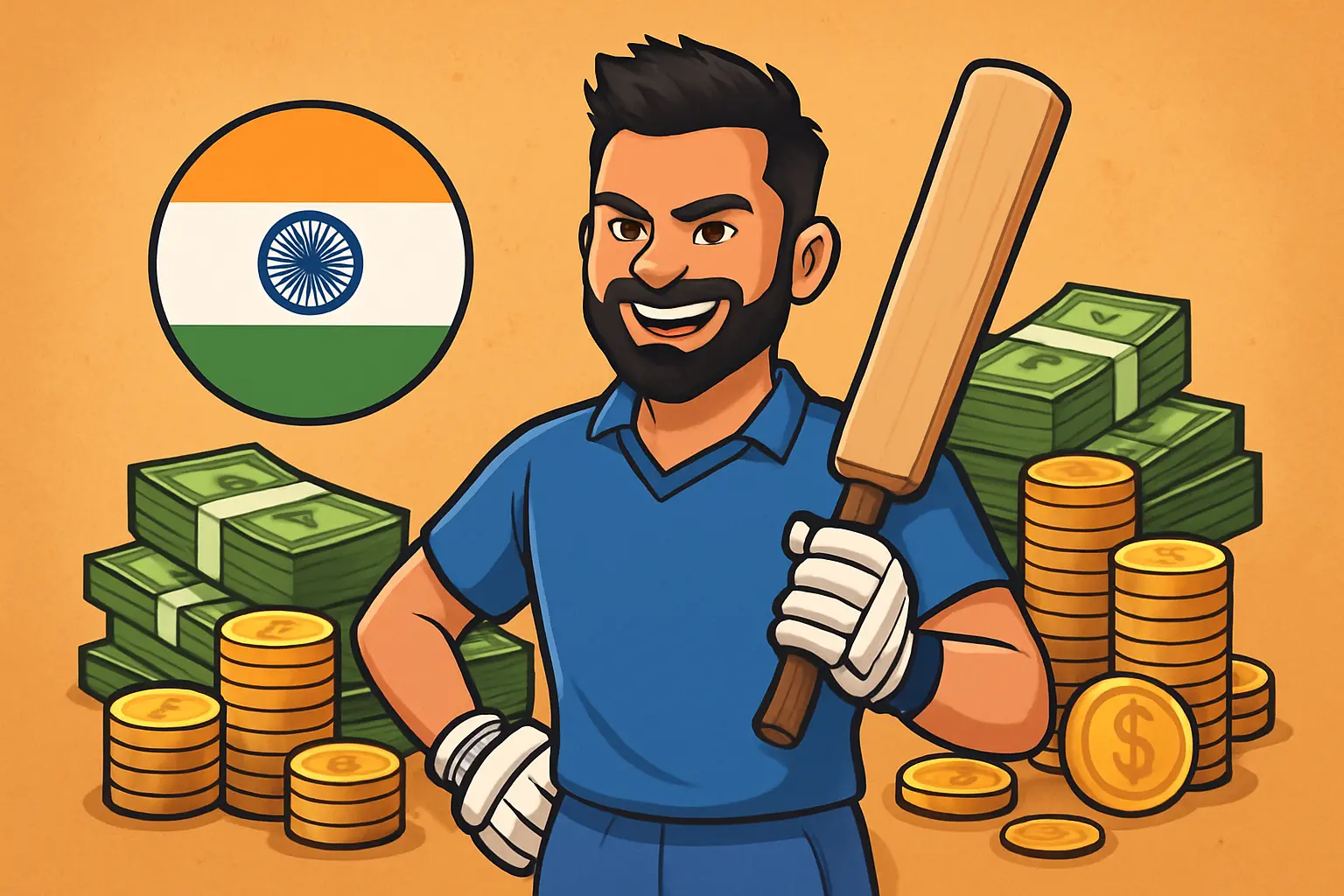Introduction: The whiteboard behind the trophies
Step inside the India dressing room at the end of a long tour and you’ll find more than sweaty jerseys and ice baths. There’s a whiteboard streaked with strike rates and lengths, a laptop humming with wagon wheels, and a semi-circle of players leaning into a voice that is part strategist, part teacher, part human shock absorber. That voice is the head coach, flanked by a small army of specialists who keep India’s competitive machine tuned across formats and continents.
The story of India’s national cricket team coaches stretches from the “manager” days of chalk-and-talk to today’s multidisciplinary, analytics-infused high-performance setups. The job has evolved with the game: from setting fielders in a Test to designing microcycles for fast-bowlers’ workloads, from finessing Rohit or Kohli’s batting rhythm to unlocking the first-class kid who has just arrived wide-eyed for his first national nets. This is a definitive, evergreen hub for india national cricket team coaches—men, women, A teams and U19—complete with an updated coach list, current staff, processes, salaries, and the impact metrics that matter.
Current coaching staff: Team India (Men)
The men’s setup today reflects the realities of three-format cricket, frequent travel, and a larger-than-ever player pool. The head coach sets the tone; the assistants translate intent into practice plans; the analyst distills data into actions; and the support staff hold the operation together through illness, injury, and the endless grind.
- Head Coach (Team India Head Coach): Gautam Gambhir
- Assistant/Batting Coach: Abhishek Nayar
- Bowling Coach: Appointed/rotated based on series needs through BCCI; NCA fast-bowling specialists have supported the transition into the new coaching cycle
- Fielding Coach: T. Dilip
- Physiotherapist: Kamlesh Jain
- Strength & Conditioning Coach: Soham Desai
- Performance Analyst: Hari Prasad Mohan
- Throwdown Specialists: Raghavendra, Nuwan Seneviratne, Dayanand Garani
- Logistics/Team Manager and Doctor: As nominated per tour by BCCI
Why this blend works: Gambhir prefers clear role definition and tactical discipline. Nayar’s presence in the batting role adds hands-on mentorship—he’s known for targeted drills and scenario training. Dilip, retained for fielding, has maintained India’s excellence in catching intensity and ground fielding standards. The rest of the backroom, from physio to S&C to analysts, are part of an experienced core that has worked consistently with the national team and at the NCA.
Note on bowling coach: Through the recent transition, BCCI has managed the bowling workload with NCA-aligned specialists supporting the touring party. This has ensured continuity in planning and rehab, even as the permanent appointment cadence has aligned to the broader coaching cycle. BCCI’s official communication remains the single source of truth for any change in that position.
What the head coach actually does in the India setup
The head coach in Indian cricket carries a multi-axis mandate:
- Tactical and selection interface: Works with the captain and selection committee to align squad profiles with opposition and conditions. The goal is match-up readiness without sacrificing identity.
- Skill development: Sets individualized work-ons. For a middle-order player that could mean improved spin options; for a seamer, a white-ball variation suite with clarity on when to deploy it.
- High-performance culture: Fitness, accountability, role ownership. This is where Team India has transformed under successive regimes, from Yo-Yo baselines to repeat-sprint standards and recovery protocols.
- Integration with NCA: Injury returns and pathway promotions (India A to India). This is a critical pipeline partnership the best coaches nurture.
- Communication and crisis management: Selection calls, media storms, rain-curtailed deciders—when the room gets hot, the coach cools it with clarity.
India cricket team coach list: Head coaches by era and impact
India’s head coach history tells a story of tactical evolution, generational shifts, and how leadership styles shaped results. The list below captures the flow from “manager-coaches” to modern high-performance leaders. Instead of dates, think in sequences and phases.
Table: India head coaches — sequence, tenure length, major trophies, signature imprints
| Coach | Tenure Length | Major Trophies | Signature Imprints |
|---|---|---|---|
| Ajit Wadekar | Multi-season tenure | Asia Cup titles; home dominance | Early structure-building, batting cohesion |
| Sandeep Patil | Short tenure | Key bilateral wins | Aggressive batting approach, youth backing |
| Madan Lal | Short tenure | Home series wins | Pace-bowling attention and grit |
| Anshuman Gaekwad (first term) | Short-medium | Stabilized transitions | Calmness amid ODIs’ rise |
| Kapil Dev | Short | Mixed results | Emphasis on fast bowling mentality; turbulent period |
| John Wright | Multi-season | Overseas Test breakthroughs; iconic Lord’s chase | First modern foreign coach; data basics; partnership with Ganguly |
| Greg Chappell | Medium | Bold selections; polarizing methods | Role experimentation; fitness-first resets; communication gaps |
| Chandu Borde (interim) | Brief | Stabilization phase | Veteran stewardship during a reset |
| Gary Kirsten | Multi-season | ODI World Cup; Test No. 1 rank | Player-led culture; Dhoni-Kirsten axis; batters’ peak years |
| Duncan Fletcher | Multi-season | Champions Trophy; away limited-overs success | Transition management from seniors to a new core |
| Ravi Shastri (Team Director) | Medium | Aggressive revival; away fight | Clarity of roles; fitness revolution foundation |
| Anil Kumble | Short | Dominant home Tests; Champions Trophy final | Ruthless planning; DRS trust; structured processes; abrupt end after captain-coach disagreement |
| Ravi Shastri (Head Coach) | Multi-season | Back-to-back Test series wins in Australia; Test Mace; WTC final berth | “No fear” cricket; Bharat Arun and R. Sridhar’s excellence; batting reset with Bangar/Rathour |
| Rahul Dravid | Multi-season | T20 world title; Asia crown; depth in bilaterals | Pathways integration; flexible templates; youth promotion; calm strategies |
| Gautam Gambhir | Current | Early tactical stamp; aggressive match-ups | Intent-based roles; IPL learnings scaled to international demands |
Coach impact, decoded beyond trophies
- Away Test wins as identity: Wright unlocked belief; Shastri turned it into a habit. Selection courage—playing five bowlers overseas, trusting young quicks—wasn’t an accident.
- Limited-overs game speed: Under Kirsten, India’s batting found peak maturity; under Dravid, white-ball depth swelled as players understood matchup roles in the powerplay and death.
- Fielding quantum leap: R. Sridhar’s era pushed India among the best fielding sides. Dilip has carried that baton with laser-focused catching metrics and practice design.
- Fitness and the “engine room”: The Yo-Yo number got headlines, but the deeper story is repeat-sprint standards and recovery hygiene. Shastri’s staff drove it; Dravid maintained it; Gambhir treats it as a selection non-negotiable.
- Pathways as competitive advantage: India A, U19, and NCA alignment built a conveyor belt. When a first-choice seamer sits out, the replacement bowler arrives knowing the plan.
Key lieutenants who shaped eras
- Bharat Arun (bowling): From wobble-seam adoption to workload care, Arun’s influence carried India’s pace pack to historic heights.
- R. Sridhar (fielding): Ground fielding, anticipation, and throw techniques were transformed.
- Sanjay Bangar and Vikram Rathour (batting): Technique meets role clarity; top-order adjustments; middle-over plans vs. quality spin.
- Paras Mhambrey (bowling): Seam-bowling development plus juniors-to-seniors continuity.
- T. Dilip (fielding): High catches and one-handed takes under pressure; repeatable drills that travel well.
India cricket team support staff: Who does what on a tour
- Batting coach: Beyond throwdowns. Deep dive into attack/defend options per opponent bowler. Knows when to leave a player alone and when to tweak backlift by a few inches.
- Bowling coach: Oversees plan trees per batter. For example, an off-stump wobble-seam channel into the surface before springing the fuller in-ducker once reverse begins.
- Fielding coach: Turns skill into repeatable excellence. Slip-cordon choreography in Tests; inner-ring angles in T20Is; transition footwork drills.
- Physiotherapist: Monitoring workloads in real time; return-to-play progression; coordination with NCA.
- S&C coach: Strength blocks between series; micro-doses during tours; speed maintenance; hamstring risk mitigation.
- Analyst: Builds opposition dossiers; interprets data within the coach’s philosophy. Knows when data must yield to form or conditions.
- Team manager: Travel, logistics, incidentals—everything invisible until it goes wrong.
BCCI head coach selection process and eligibility
How Team India’s head coach is chosen matters as much as who gets chosen. The selection architecture blends governance with cricket sense.
Process
- BCCI publishes an open call for applications with criteria and timelines.
- The Cricket Advisory Committee (CAC)—generally comprised of former India internationals—shortlists and interviews candidates.
- Candidates present their vision: format strategies, captain-coach interface, NCA alignment, staffing proposals.
- CAC recommends; BCCI ratifies and negotiates contract terms.
- Support staff are appointed in consultation with the head coach and BCCI.
Eligibility and credentials
- Preferred: BCCI Level 3 certification (or equivalent international qualification), prior coaching experience at high level, or extensive international playing experience with proven coaching aptitude.
- Strong familiarity with Indian domestic pathways, IPL ecosystems, and NCA rehab/return-to-play structures.
- Communication across languages and cricket cultures; ability to manage mega-stardom without losing the room.
How to apply for BCCI coaching jobs
- Monitor BCCI’s official site and verified releases for application windows.
- Keep certifications updated (BCCI Level 1, Level 2, Level 3; NCA courses).
- Compile a portfolio: coaching philosophy, evidence of player development, competition results, references.
NCA coaching certification in India
- The National Cricket Academy (NCA) runs structured coaching courses and continuous professional development.
- Modules emphasize skill teaching, biomechanics, analytics, talent ID, and periodization.
- NCA also aligns with state associations for identification and development of coaching talent.
Indian cricket team coach salary and contracts
Working with Team India is high pressure and high reward. While exact figures vary by contract and performance clauses, the general ranges have been consistent in recent cycles.
- Head coach: Typically in eight figures (INR) annually, with performance bonuses for ICC trophies and major series wins. Housing, travel, and per diems are covered; bonuses can be significant for global titles.
- Assistant/Batting, Bowling, Fielding coaches: Competitive seven-figure (INR) ranges annually, plus bonuses.
- Physiotherapist, S&C, Analyst: Generally in the upper six to lower seven figures (INR), depending on seniority and specialization.
- Contract length: Multi-season commitments with review checkpoints. Extensions and role adjustments are common across cycles, especially if ICC events fall mid-contract.
Women’s national team: Coaches, structure, and momentum
The women’s setup has matured rapidly. India Women have moved from nearly-there stories to consistent contention across formats and events, underpinned by increasingly professional coaching and pathway attention.
- Head Coach (India Women): Amol Muzumdar
- Bowling, Fielding, S&C, Analyst: Appointed via BCCI and coordinated with the NCA women’s program; touring roles announced per series and tournaments
- Recent coaching arc: The program has blended technical rigor with the freedom to chase games aggressively. Coaches have emphasized power-hitting development, wristspin depth, and fitness metrics that match the accelerating pace of the women’s game.
- Pathway synergy: The women’s U19 triumph on the global stage under coach Nooshin Al Khadeer signaled a pipeline ready to feed the senior side. The alignment of academy and national plans ensures smoother transitions for teen prodigies.
India A and U19: The coach-fueled conveyor belt
The biggest competitive advantage for Indian cricket over the last decade has been coaching alignment between India A, U19, and the senior team. This is not administrative jargon—it’s why an uncapped quick can hit the right lengths in Brisbane on debut, or a young batter can answer wristspin in a regional final and then do it in a packed stadium three months later.
- India A Head Coach: Sitanshu Kotak has long anchored the role, with seasoned assistants like Sairaj Bahutule (bowling) and Abhay Sharma (fielding) contributing across tours.
- U19 Head Coach: Appointed cycle by cycle; names like Rahul Dravid, Paras Mhambrey, Hrishikesh Kanitkar, and Sairaj Bahutule have shaped generations.
- What India A/U19 coaches actually do:
- Build role-ready players rather than stat-padding machines.
- Stress-test skills in SENA tours (South Africa, England, New Zealand, Australia) and spin-heavy tournaments at home.
- Mirror senior team tactics: powerplay intent, death overs game awareness, slip-catching standards for red-ball.
- Seamlessly hand over scouting notes and work-ons to the senior coaching staff.
NCA: The high-performance glue
- Head of NCA: VVS Laxman
- The NCA is India’s performance brain, where rehab meets skill reinvention. It holds baseline testing, workload logs, and individualized strength plans for contracted players.
- Coaches across skill domains (fast bowling, spin, batting, wicketkeeping) coordinate with state associations, IPL franchises, and the national staff to keep a common language of development.
- The NCA’s evolution: Today it’s as much about prevention and return-to-play control as about technique. Think of it as a long-term project manager for Indian cricket’s bodies and games.
Coach-by-coach: What changed on the field
Ajit Wadekar
- Contribution: He brought structure to the “manager-coach” role, giving India a coherent preparation template for ODIs and Tests.
- Impact: Early Asia Cup success and home series control, with a batting unit that understood roles better than before.
John Wright
- Contribution: Calm exterior, meticulous planning. Data usage at a basic but vital level. Trusted Sourav Ganguly’s front-foot leadership.
- Impact: Memorable away Test wins, a famous ODI chase at Lord’s that emboldened a generation, and the early formation of a fearless middle order.
Greg Chappell
- Contribution: Role clarity and fitness standards were pushed hard; experimentation was relentless.
- Impact: Uneasy dressing room environment overshadowed the method. Yet, several selection and role ideas later bore fruit once retuned under gentler man-management.
Gary Kirsten
- Contribution: Ego-free, player-first culture; tactical simplicity with high execution.
- Impact: ODI World Cup on home soil; Test team took top spot; senior batters produced some of their best years. Dhoni and Kirsten formed an iconic axis.
Duncan Fletcher
- Contribution: The most underrated of India’s modern coaches. Quietly engineered India’s limited-overs adaptability overseas.
- Impact: Champions Trophy, and a crucial transition from legends to a new white-ball core.
Ravi Shastri (Team Director, then Head Coach)
- Contribution: The tone-setter of modern India’s identity—fitness, aggression, clarity. Empowered the bowling group with Bharat Arun’s science and method.
- Impact: Two historic Test series wins in Australia; relentless home dominance; a fast-bowling quartet that could win anywhere; fielding standards escalated under R. Sridhar.
Anil Kumble
- Contribution: Surgical planning, tactical sharpness, trust in DRS as a weapon, and the beginnings of a wristspin thread in white-ball.
- Impact: A short but high-performing tenure that ended abruptly. The on-field product was clinical; off-field dynamics proved brittle.
Rahul Dravid
- Contribution: A coach for a sprawling system. Integrated pathway players, normalized role rotations, and made the bench as ready as the XI.
- Impact: A T20 world title, Asia-level dominance, and a white-ball method that balanced intent with stability. Quiet innings wins in Tests were built on clarity of plans, even when transition pains were visible.
Gautam Gambhir
- Contribution: Intent with batters, sharp matchup cricket, and non-negotiable fitness. A coaching voice that mirrors his playing intensity.
- Impact: Early in tenure, but tactical fingerprints show: more defined finishing roles, aggressive powerplay plans, and spin-matchup micro-plans tailored to venues.
India cricket team coaches and trophies: What really matters
- ICC global titles: The ODI crown on home soil under Kirsten, the global T20 title under Dravid, and the Champions Trophy under Fletcher stand as timeline markers of method meeting moment.
- Asia crowns: Multiple wins across cycles reflect India’s bench depth and situational awareness in subcontinental conditions.
- Test supremacy: Sustained periods at or near the top came from a five-bowler mindset away, aggressive declarations at home, and bite in spin and seam.
Coach impact metrics (beyond the obvious)
- Home vs away Test split: Coaches who encouraged attacking selections away from home—four quicks plus a spinner; an extra batter as conditions demanded—saw dividends. Fitness standards ensure spells don’t dip after the second new ball.
- Format splits:
- T20Is: Clearer roles for powerplay hitters and bowling plans by phase matter. Coaches who embraced data without letting it dominate instinct found the sweet spot.
- ODIs: The middle overs still define India; batting coaches who empower spin-hitting options beyond slog sweeps improve strike-rotation and boundary frequency.
- Tests: Session-by-session seam lengths, field catching endurance, and repeatable batting defense methods against high pace and high-quality spin separate good from great.
- Player development: Who elevated the fringe? A hallmark of great Indian coaches is the ability to coax a 15th-player impact at crunch time.
Role-wise evolution: Batting, bowling, fielding coaches through the years
- Batting coaches: From Sanjay Bangar to Vikram Rathour to Abhishek Nayar, the shift has been from generic throwdowns to individual blueprints. Top-order batters learned to modulate against hard lengths; middle-order players embraced power progressions, from bat-speed work to zone hitting.
- Bowling coaches: Bharat Arun brought seam skill and workload remodeling; Paras Mhambrey knitted the pathway flow and white-ball variation depth; the current cycle leverages NCA’s specialist network to maintain continuity even during staff transitions.
- Fielding coaches: R. Sridhar made India world-class; T. Dilip is maintaining intensity in catching practice and boundary ride discipline, a critical white-ball edge.
India women’s cricket team coach list: A quick arc
- Phases:
- Early evolutions with domestic stalwarts leading.
- A firming-up period under coaches who professionalized routines, scouting, and fitness standards.
- The current era under Amol Muzumdar that emphasizes both technical depth and fearless intent.
- What’s changed:
- More organized spin plans against big sides.
- Power-hitting development cycles for top- and middle-order batters.
- Pace-bowling skill-stacks with in-swing/out-swing ownership and death bowling clarity.
- Fielding courage—diving stops, boundary technique—and direct-hit practice.
India A and U19 coach list: Names that built the backbone
- India A: Sitanshu Kotak’s steady hand with Sairaj Bahutule’s bowling craft and Abhay Sharma’s fielding detail has produced a ready-to-play cohort.
- U19: Rahul Dravid’s blueprint years still echo. Hrishikesh Kanitkar’s title-winning calm, Sairaj Bahutule’s bowling clinics, and a culture of rotating captains to build decision-making under pressure.
The BCCI–NCA pathway for coaches: How you climb
- Start with BCCI Level 1: Fundamentals—technique, nets management, safety.
- Progress to Level 2: Advanced drills, match strategy, psychology.
- Level 3: High-performance direction—periodization, data usage, individualized plans, staff leadership.
- NCA attachments: Shadow senior coaches during A and U19 camps; submit session plans and reflection reports.
- State association roles: Build a track record in domestic cricket; work with IPL development squads where possible.
- National gigs: Apply when windows open; bring a portfolio that shows player improvement, not just wins.
Comparisons: Best India cricket team coach by stats and imprint
- Best Test-away impact: Ravi Shastri’s era, thanks to a relentless fast-bowling battery and selection courage.
- Best all-format trophy imprint: Gary Kirsten’s ODI world title plus No. 1 Tests is a dual peak that few nations have matched.
- Best development footprint: Rahul Dravid, for knitting NCA, U19, India A, and the senior side into one breathing organism.
- Best fielding transformation: R. Sridhar’s tenure scaled India’s athleticism; T. Dilip has kept the needle high.
- Best white-ball tactical crafting: India’s modern groups under Shastri and Dravid shifted from anchor-heavy to role-driven batting, a transition Gambhir is sharpening with matchup thinking.
Coach vs captain combinations that shaped eras
- Ganguly–Wright: The origin story of fearless overseas cricket; youngsters backed hard, veterans repurposed.
- Dhoni–Kirsten: Poise and clarity. Mastered pressure. Players say they were heard; plans felt simple.
- Kohli–Shastri: Fitness and fire. Attack mindset in Tests, even away; bowlers became matchwinners across conditions.
- Rohit–Dravid: Calm authority. White-ball elasticity with better bench depth. Multi-skilled XIs with contingencies baked in.
- Rohit/Hardik–Gambhir: Tactical precision; powerplay aggression in batting and bowling; flexibility without panic.
Current staff snapshots (concise tables)
Table: Team India (Men) — Current staff
| Role | Name |
|---|---|
| Head Coach | Gautam Gambhir |
| Assistant/Batting Coach | Abhishek Nayar |
| Bowling Coach | Appointed per series; NCA-supported |
| Fielding Coach | T. Dilip |
| Physiotherapist | Kamlesh Jain |
| Strength & Conditioning | Soham Desai |
| Performance Analyst | Hari Prasad Mohan |
| Throwdown Specialists | Raghavendra; Nuwan Seneviratne; Dayanand Garani |
Table: India Women — Current top roles
| Role | Name/Coordination |
|---|---|
| Head Coach | Amol Muzumdar |
| Pathway/NCA Coordination | Through NCA women’s program; bowling, fielding, S&C specialists assigned per tour |
Table: Pathway — India A and U19
| Team/Role | Name/Details |
|---|---|
| India A Head Coach | Sitanshu Kotak |
| Bowling/Fielding (A) | Sairaj Bahutule, Abhay Sharma among regulars |
| U19 Head Coaches (by cycle) | Appointed by BCCI; recent cycles have featured Hrishikesh Kanitkar and Sairaj Bahutule in lead roles, with Nooshin Al Khadeer distinguished on the women’s U19 side |
Coach selection truths: What CACs look for
- Philosophy that matches India’s talent surplus: Coaches must harness depth without drowning in it.
- Communication skill: Between superstar management and fringe nourishment.
- Cohesion with selectors, captains, and NCA: No ego walls; only performance bridges.
- Learning mindset: The game changes monthly. The best Indian coaches update, not ossify.
The economics and structure of support staff
- India’s backroom is intentionally deep. Analysts now handle opponent pattern maps (for example, how an opening batter’s control percentage changes when the bowler switches to around the wicket with a heavy leg-side field).
- S&C staff personalize in-season micro-doses, shifting from heavy lifts to neural freshness before game day.
- Physiotherapists coordinate with team doctors and NCA’s sports science heads, a chain that speeds up safe returns post-injury.
- Fielding coaches own high-chance catches under lights—a quiet differentiator in knockout games.
Behind-the-scenes vignettes that reveal coaching value
- The seam-length whisper in the drinks break overseas: India’s bowling coach suggests moving the seam from upright to a slightly scrambled presentation to exploit soft reverse. The next session brings two lbws. It doesn’t trend on social media, but it wins matches.
- The batting tweak no one noticed: A middle-order player faces leg-spin poorly for two series. The batting coach adjusts his pickup to start from a fraction lower and pre-sets his back hip against the turn. The sweep returns, with control. SR bumps by a quiet 15 in the middle overs.
- Fielding coach’s invisible routine: The night before a day game, the cordon does 15 minutes in the corridor—soft hands, inside edge reflex catches off a rubber sheet. Next morning, a chance sticks in the second slip.
Hindi snapshot: भारतीय क्रिकेट टीम के कोच — मौजूदा स्टाफ
- मुख्य कोच: गौतम गंभीर
- असिस्टेंट/बैटिंग कोच: अभिषेक नायर
- बॉलिंग कोच: बीसीसीआई के माध्यम से सीरीज-आधारित नियुक्ति; एनसीए सपोर्ट
- फील्डिंग कोच: टी. दिलीप
- फिजियो: कमलेश जैन
- स्ट्रेंथ एंड कंडीशनिंग: सोहम देसाई
- एनालिस्ट: हरी प्रसाद मोहन
Coach transitions: How India manages change without chaos
- Succession planning: Likely assistants are groomed months in advance; captains are looped into staff preferences early; NCA readies replacements.
- Role preservation: Even when the head coach changes, fitness pillars and data pipelines are retained. That way a batter’s bat-speed tracker doesn’t vanish with a resignation letter.
- Communication to players: Role expectations survive coaches. Players know their A, B, and C plans before they pack for a tour.
Patterns across eras: What the data whispers
- India wins more when the bowling group is stable across a cycle. Seamers need trust, not constant churn.
- Fielding errors spike in multi-format stretches when the rotation isn’t planned. Coaches who protect fielding units with workload smartness keep drops down.
- Batting orders built with two: one anchor flexible across phases and one pure accelerator tend to score above-par more reliably than five floating anchors. Coaches shape this balance.
Eligibility to become an Indian cricket team coach: A practical map
- Credentials: Start with BCCI Level 1; build experience at the state level. Level 2 opens up assistant roles at higher levels; Level 3 is the gateway to national consideration.
- Experience: Elite playing careers help but are not mandatory. Demonstrated development success matters—show how you improved a batter’s spin game or a pacer’s death over economy.
- Portfolio: Include session plans, before-and-after data for players coached, videos of drills, and references from state/NCA coaches.
- Visibility: Present at NCA camps; publish or present on coaching forums; build networks without politicking.
India coaches before and after ICC events: A pattern of recalibration
- Before global tournaments: Coaches lock formations, define finishers, standardize death bowling patterns, and test spin-hitting under pressure in bilateral games.
- After events: Honest reviews sharpen roles and reframe selection profiles. India’s best coaches turn heartbreaks into tactical upgrades without scapegoating.
India coach win percentage and the context trap
Raw win percentage can lie. A coach with a lower ODI win% but higher away Test success might be delivering the identity India values most in that cycle. Context matters:
- Venue mix across the tenure
- Transition load (how many debutants entered)
- Injury clouds over key series
- Strength of opposition in their own conditions
Still, across eras, India’s win rates have trended upward thanks to structural coaching investments: better fitness, sharper fielding, deeper roles, and data fluency tempered by cricket sense.
Mentor and strategist roles: Occasional, and not always official
Indian cricket occasionally invites mentors or strategists for specific tours or tournaments. These roles complement, not override, the head coach. They often deliver a one-degree course correction—field sets, batting intent cues, or matchup reminders—without diluting accountability.
India women’s coaching and the power of alignment
The women’s game has accelerated technically and physically. Under the current regime:
- Younger batters are schooled early in power hitting and range—back-foot pull, inside-out loft over extra cover, slog-sweep variants.
- Spinners are trained to defend power lanes with fielding plans that protect boundaries without gifting singles.
- Fitness loads have been raised sensibly; the sprint profiles for outfielders today would surprise old hands.
- Communication has improved—roles are named, and players know how they’ll be used before a toss.
Coach–captain relationships: The alchemy
- Trust beats tactics when pressure bites. India’s best chapters came when captains and coaches argued behind closed doors and spoke one language outside.
- The coach’s job is not to be liked; it is to be believed. With belief, a batter can change a grip in mid-series; a bowler can try the hard length into the pitch on a flat deck because the room still believes it wins in the 40th over.
India national cricket team support staff list: The full ecosystem
- Head Coach, Assistant/Batting, Bowling, Fielding
- Physiotherapist, S&C, Massage Therapist
- Performance Analyst, Video Analyst
- Team Doctor, Nutritionist
- Throwdown Specialists
- Logistics Manager, Media Manager
- Security Liaison, High-Performance Consultants (as needed)
This depth reflects modern cricket reality. Margins in T20Is are a handful of balls; in Tests it’s two sessions where a team refuses to give an inch. Support staff win you those inches.
FAQ: Quick, authoritative answers
Who is the current head coach of Team India?
Gautam Gambhir.
Who is India’s batting coach right now?
Abhishek Nayar functions as the assistant/batting coach.
Who is India’s fielding coach?
T. Dilip.
Who handles India’s bowling unit at the moment?
BCCI has utilized NCA-aligned fast-bowling specialists alongside the touring party; bowling coach appointments have been communicated series by series in the new cycle.
Who was India’s coach when the men’s team won the ODI World Cup at home?
Gary Kirsten.
Who was India’s coach during the men’s global T20 title triumph in the Caribbean and USA?
Rahul Dravid.
Which coach guided India to the men’s Champions Trophy title?
Duncan Fletcher.
Who is the coach of India’s women’s team?
Amol Muzumdar.
Who leads the NCA?
VVS Laxman.
How many head coaches has India had?
Counting from the modern era of formalized appointments, India has cycled through a little over a dozen full-time head coaches, with a handful of interim stints.
What is the salary of the Indian cricket team head coach?
A high eight-figure INR annual package is common for the head coach, with performance bonuses and allowances on top.
When does the India head coach contract end?
Multi-season contracts are standard; exact end dates are announced by BCCI and may include extension options.
Who selects India’s head coach?
The Cricket Advisory Committee (CAC) interviews and recommends; BCCI appoints and contracts.
What qualifications do you need to become India’s head coach?
BCCI Level 3 or equivalent experience, proven coaching track record at high level, and deep knowledge of Indian cricket pathways.
Conclusion: Coaches as the secret architecture of Indian cricket
India’s cricketing public sees the big moments—the roar as a ball sails into the night, the stump cartwheeling from a perfect nip-backer, the open-palmed sprint after a direct hit. Behind those flashes sits the architecture built by coaches and support staff: the planning that made a bowler trust a length, the habit that made a fielder take a half-chance, the clarity that let a batter calm their hands at 12 for 2.
From Ajit Wadekar’s structured beginnings to John Wright’s modernist touch, from Gary Kirsten’s ego-free man-management to Ravi Shastri’s muscular identity, from Rahul Dravid’s system-first knitting to Gautam Gambhir’s assertion of intent, the arc is visible. The men and women who coach India carry the responsibility of turning talent into titles and pressure into performance. Their work rarely trends; it endures. And as the calendar turns and squads rotate, the playbook evolves. The constants are clarity, cohesion, and care—three words that quietly define the finest of india national cricket team coaches.
Appendix: India head coach timeline (sequence and hallmark)
- Ajit Wadekar — Asia crowns; structure
- Sandeep Patil — Attacking batting; youthful energy
- Madan Lal — Grit; home stabilization
- Anshuman Gaekwad — Calm transitions
- Kapil Dev — Fast-bowling mentality; turbulent period
- John Wright — Overseas belief; Lord’s chase era
- Greg Chappell — Role experiments; polarizing environment
- Chandu Borde (interim) — Stabilization
- Gary Kirsten — ODI world title; Test summit; player-first
- Duncan Fletcher — Champions Trophy; transition management
- Ravi Shastri (Team Director) — Aggressive reboot; fitness base
- Anil Kumble — Surgical planning; short, strong run
- Ravi Shastri (Head Coach) — Australia conquests; fearlessness
- Rahul Dravid — T20 world title; pathways synergy
- Gautam Gambhir — Intent era; matchup precision
Keep this page bookmarked. Coaching staffs will turn, assistants will rotate, and young specialists from the NCA will step into the lights. The whiteboard keeps updating. The architecture stands.

